NEET Biology Notes Respiration In Plants Cellular Respiration
Cellular respiration (the term given by Dutrochet) is essentially a catabolic process, that involves the biological oxidation of organic molecules, and results in the release of energy in the form of ATP. ATP (adenosine triphosphate) is a derivative of AMP (adenosine monophosphate) to which two additional phosphate groups are attached through an anhydride linkage. The two bonds are indicated by the symbol (-). When the first high-energy phosphate bond is hydrolyzed, 8.9 kcal of energy is released.
- When the second phosphate bond is broken, 6.5 kcal of energy is released. However, if the third phosphate group (i.e., of AMP) is hydrolyzed, only 3.4 kcal of energy is liberated. The energy released by the breaking down of phosphate groups in ATP and ADP (adenosine diphosphate) is much more than the energy released on the hydrolysis of most of the other covalent bonds.
- ATP is an instant source of energy within the cell. It is mobile and transports chemical energy to the energy-requiring processes within the cell. Since ATP is found in all living cells, it is called the “universal enemy carrier” or “energy currency” of cells.
Aerobic Respiration
Aerobic respiration takes place in the presence of oxygen. Complete oxidation of the substrate results in the formation of CO2 and water accompanied by the release of energy, for example, In most forms of life, respiration occurs aerobically.


Anaerobic Respiration
Anaerobic respiration takes place in the absence of oxygen and results in incomplete degradation of the substrate to CO2 and organic compounds such as ethyl alcohol, lactic acid, etc., accompanied by the release of some energy. Water is not a product of this reaction.

” respiration in plants class 11 handwritten notes”
- Usually, anaerobic respiration occurs in the deep-seated tissues of plants and animals, in germinating seeds, in fruits, and among many microorganisms, for example, yeasts and bacteria.
- A large variety of organisms (anaerobic) employ anaerobic respiration as their major energy-yielding process. Some bacteria are even killed if exposed to a substantial amount of oxygen. These are termed obligate anaerobes. The organisms which can respire both in the presence and absence of oxygen are called facultative anaerobes.
Read and Learn More NEET Biology Notes
NEET Biology Notes Respiration In Plants Respiratory Quotient
Respiratory quotient (RQ) is the ratio of CO2 volume released to oxygen volume absorbed during respiration and is written as:

- The value of RQ varies with the substrate. Thus, the measurement of RQ gives some idea about the nature of the substrate being respired in a particular tissue. The value of RQ is usually measured by Ganong’s respirometer.
- When carbohydrates act as respiration substrates (germinating wheat, oats, barley, paddy grains, green leaves kept in the dark, tubers, rhizomes, etc.).
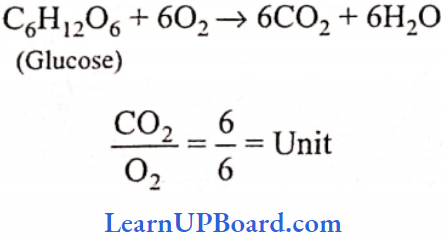
When fats act as respiratory substrate (germinating castor, mustard, linseed, til seeds, etc.): Fats are poorer in O2.
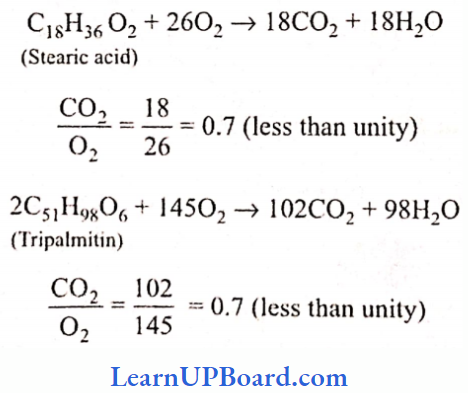
When proteins act as respiratory substrates (germinating gram, pea, bean, mung seeds, etc.). The value of RQ is less than unity (0.5- 0.9): Proteins are also poor in O2. When an organic acid acts as a respiratory substrate: Organic acids are rich in O2.
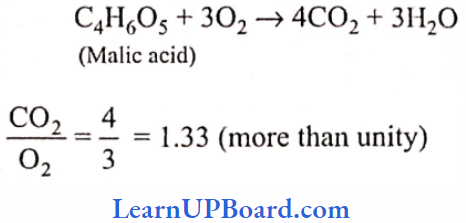
Incomplete oxidation of carbohydrates occurs during the night when stomata are open.
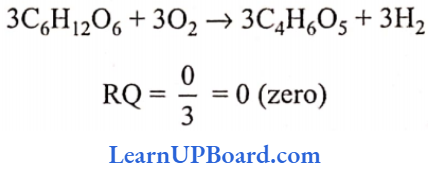
In the absence of O2 (anaerobic respiration).
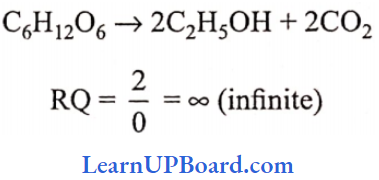
RQ of maturing fatty seed is greater than 1. The RQ of a mixed diet is 0.85. The RQ of starved leaves is less than 1. The RQ of colored petals is less than 1.
NEET Biology Notes Respiration In Plants Glycolysis Or Emp Pathway
In aerobic as well as anaerobic respiration, the initial sequence of events is the same, collectively tanned as glycolysis. Glycolysis (splitting of sugar) results in the breakdown of one molecule of glucose into two molecules of pyruvic acid. It is completed in the cytoplasm of the living cells, not in the mitochondria, and also does not require the presence of oxygen. It is also known as the Embden Meyerhof Pamas (EMP) pathway after the names of three German scientists who discovered it.
“respiration notes “
- The first half of this pathway activates glucose (glucose activation phase; The second half extracts the energy (energy extraction phase). Glycolysis yields only 5% of the total ATP production and 2% of the total energy content of glucose.
- All the reactions of EMF are reversible except for those catalyzed by hexokinase, phosphofructokinase, and pyruvate kinase. Nearly all enzymes require Mg2+ as a cofactor. The brain, retina, skin, and gastrointestinal tract derive most of their energy from glycolysis. It is the only source of energy in RBC.
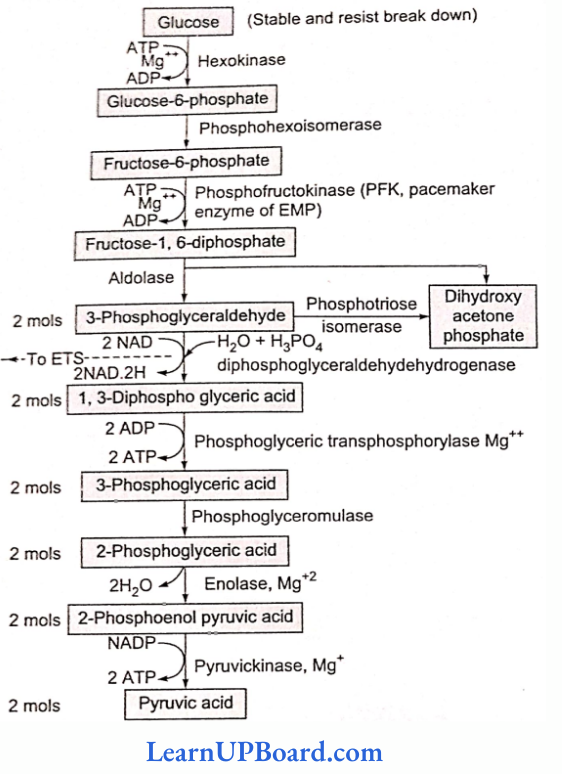
Reactants Used And The End Products During Glycolysis:
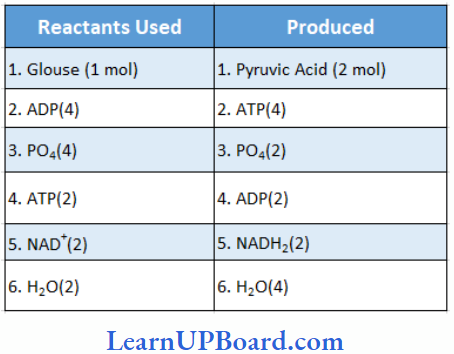
NEET Biology Notes Respiration In Plants Fate Of Pyruvic Acid
In aerobic oxidation, each pyruvic acid molecule enters mitochondria where its oxidation is completed. It is carried out in the following phases: oxidative decarboxylation (formation of acetyl CoA) and Krebs cycle.
Oxidative Decarboxylation (Formation of Acetyl Coenzyme A)
- Pyruvic acid molecules produced during glycolysis move into the mitochondria and all reactions of cellular respiration take place within these tiny powerhouses. Here each three-carbon molecule of pyruvic acid is decarboxylated (i.e., CO2 is released) and dehydrogenated (i.e., hydrogen atoms are removed).
- Due to the release of CO2, the three-carbon molecule of pyruvic acid is converted to a two-carbon acetyl group which reacts with a large complex coenzyme called coenzyme A. This results in the formation of a compound called acetyl coenzyme A.
- This process requires five cofactors, namely, Mg++, thiamine pyrophosphate (TPP), NAD, coenzyme A, lipoic acid, and a huge enzymatic complex of three enzymes called pyruvate dehydrogenase

Acetyl coenzyme A is often called the substrate entrant of the TCA cycle and is a link between glycolysis and the TCA cycle. It is also linked with fat metabolism.
TCA Cycle (Krebs Cycle Or Citric Acid Cycle): The reactions of this cycle were worked out by Sir Hans Adolf Krebs in the flight muscles of pigeons. In these reactions, hydrogen atoms are removed from acetyl CoA and transferred to coenzymes for further processing in the electron transport system.
- The cycle is called the citric acid cycle (because of the formation of citric acid in the first step in this cycle) or the TCA cycle (tricarboxylic acid cycle, because many intermediate compounds formed in the cycle have three carboxyl groups).
- The reactions of the Krebs cycle require the presence of oxygen and are confined to the mitochondrial matrix. This cycle serves as a common oxidative pathway for carbohydrates, fats, and proteins.
- All enzymes are soluble in the mitochondrial matrix but succinate dehydrogenase is found attached to the inner mitochondrial membrane. One molecule of ATP (via GTP), three NADH2, one FADH2, and two molecules of CO2 are released per molecule of costly CoA oxidized; however, as two molecules of pyruvic acid are formed from one glucose molecule, the TCA cycle must occur twice for each molecule of glucose respired.
- Therefore, two ATP, six NADH2, and two FADH2 are formed from two molecules of acetyl CoA (coming from one molecule of glucose). Some intermediates of the cycle are moreover used in synthesizing important biomolecules such as glutamate and aspartate. Krebs cycle involves a total of nine steps. The reactants and products per acetyl coenzyme A in the Krebs cycle.
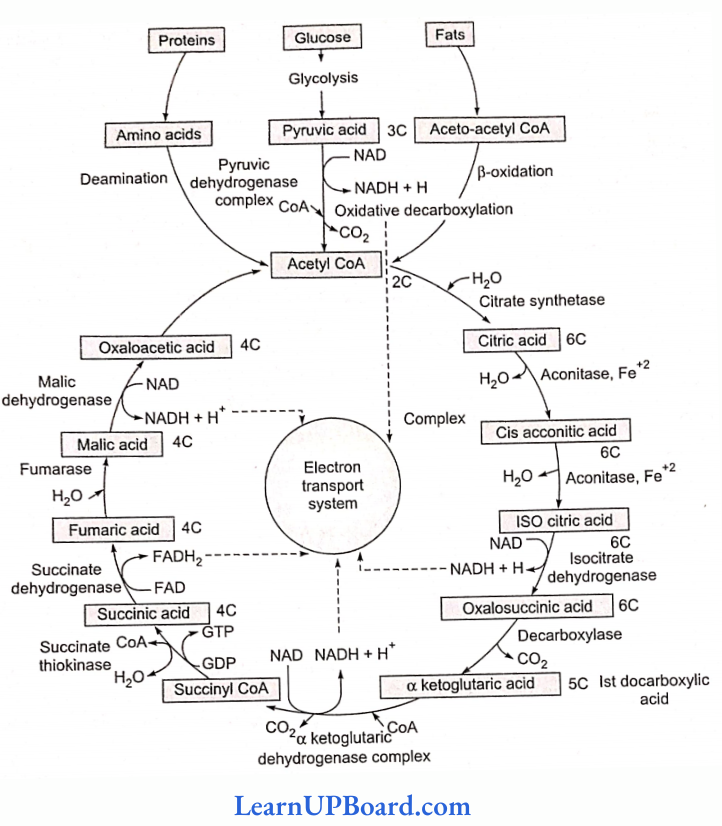
Reactants used and end products in the Krebs cycle:

The TCA cycle has both catabolic and anabolic pathways (amphibolic). Various intermediates of the cycle are precursors of various compounds, for example.
- Acetyl CoA → Raw material for carotenoids, terpenes, gibberellins, etc.
- Succinyl CoA → Raw material for chlorophyll, cytochromes
- Oxaloacetic Acid → Raw material for alkaloids, pyrimidines
NEET Biology Notes Respiration In Plants Electron Transport System
Reduced coenzymes (NADH2, FADH2,) generated in glycolysis (2 NADH2), oxidative decarboxylation (2 NADH2), and TCA cycle (6 NADH2, 2 FADH2) are transferred to the electron transport system (ETS) embedded in the inner mitochondrial membrane.
- They are oxidized in the presence of O2 liberating energy and regenerating NAD and FAD. ETS comprises several electron-carrying proteins divisible into five multiprotein complexes. Four of these complexes are concerned with electron transfer while the fifth complex is concerned with ATP synthesis.
ETS has seven electrons and an H+ carrier, viz., FAD, FMN, CoQ, cyt b, cyt c, cyt a, and cyt a3. Two mobile electron carriers CoQ and cyt c. These complexes are:
- NADH-dehydrogenase complex: Have prosthetic group FMN, FeS.
- Succinate dehydrogenase complex: Have prosthetic group FAD, FeS
- Cyt c-reductase complex: Have cyt b, c
- Cyt c-oxidase complex: Have cyt a Cua, Cub, cyt a3.
- ATPase (F0-F1 particle).
“respiration in plants diagram “
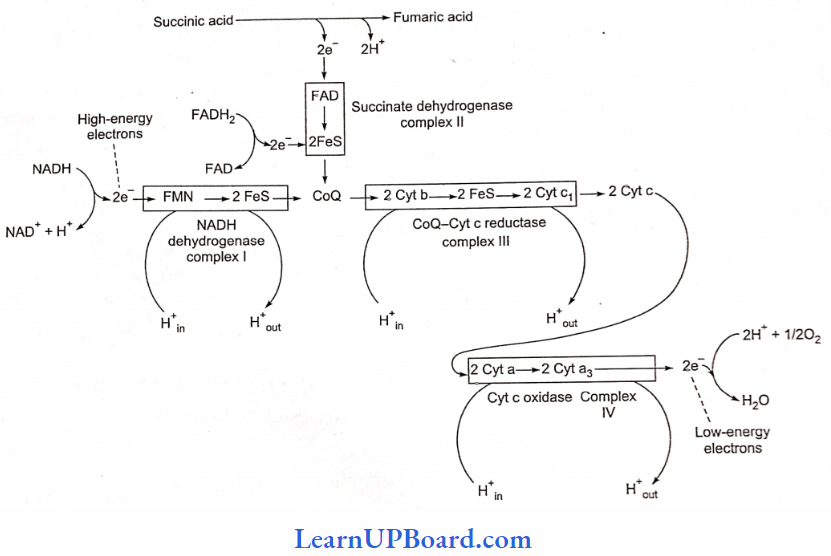
Electron and Proton Flow in ETS
O2 reacts with terminal H+ and finally, e– acceptor in ETS to form metabolic water. Reduced coenzyme NADH2 helps in pushing three pairs of H+ to the outer chamber of mitochondria while FADH2 sends two pairs of HT to the outer chamber.
Oxidative Phosphorylation: It is the synthesis of ATP (from ADP and inorganic phosphate) which occurs with the help of energy obtained from the oxidation of reduced coenzymes formed in cellular respiration. ATP synthesis is explained by the chemi-osmotic theory of Mitchell (1961, Nobel Prize 1978).
- The energy liberated during electron transport is used in building a proton gradient or proton motive force (PMF) in the outer chamber—three pairs of protons during the oxidation of each NADH + H+ and two pairs of protons during the oxidation of each FADH2.
- The inner mitochondrial membrane has F0-F1 or ATPase or elementary particles for proton transport. The F0 parts of elementary particles function as proton tunnels.
- The stalk part of elementary particles has coupling factors while heads have ATPase proper for ATP synthesis.
- Two protons entering an elementary particle knock out one oxygen of inorganic phosphate and convert the latter into energy-rich or active phosphate which combines with ADP to form ATP. The complete oxidation of NADH forms three ATP molecules while one FADH2 forms two ATP molecules.
” ch 14 bio class 11 notes”
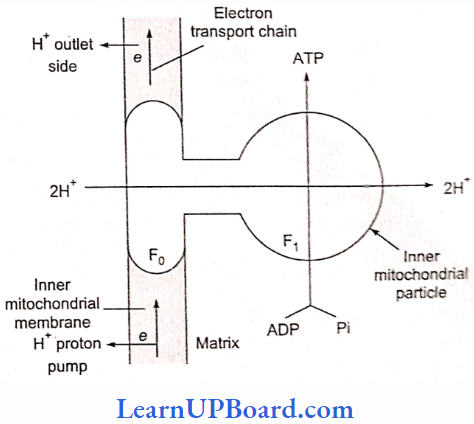
Electron Transport System: Reactants And Products:
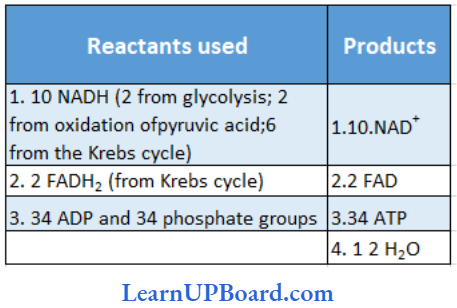
NEET Biology Notes Respiration In Plants Pentose Phosphate Pathway
Pentose phosphate pathway (PPP) Warburg-Lipman-Dickens cycle or hexose monophosphate shunt (HMS) is an alternative pathway occurring in cytoplasm and chloroplast in the presence of O2 and is found both in prokaryotes and eukaryotes. It was first studied by Warburg et al. (1935) and Dickens (1938). It is favored by the presence of NDP. It acts as a safety valve and a shunt to DAP. The important characteristics are:
- Hexoses are converted to pentoses.
- Direct oxidation of glucose to CO2 and H2O.
- Synthesis of important intermediates such as NADPH2, ribose, and erythrose 4-phosphate.
- Important in tissues such as the liver, ovary, testes, adipose tissue, and germinating seeds.
- Low activity in skeletal muscles.
In this cycle, out of six glucose 6-phosphate molecules entering, only one is completely oxidized, while the other five are regenerated. The complete degradation of one glucose molecule leads to the formation of 12 molecules of NADPH2, which ultimately yields 36 ATP molecules, while the net yield is 35 ATP molecules.
NEET Biology Notes Respiration In Plants Types Of Anaerobic Respiration And Fermentation
Different types of anaerobic respiration and fermentation (also called intramolecular respiration) are as follows:
- Alcoholic fermentation/anaerobic respiration: It is the most common type of fermentation taking place in yeast and bacteria and parts of higher plants. The term fermentation was first of used by Pasteur in 1857 for the alcoholic fermentation of yeast. Buchner (1897) extracted zymase complex enzymes from yeast cells.
- Fermentation takes place in the solution of large numbers of sugar, fructose, galactose, mannose, and disaccharides. In fermentation by yeast, when the percentage of alcohol in the sugar solution is 9-18%, yeast cells are killed, and fermentation stops.
- At the time of germination of seeds, the amount of sugar increases so that fermentation takes place in barley germinating grains. Alcoholic fermentation takes place in two steps. In the first step, pyruvic acid is decarboxylated resulting in the formation of acetaldehyde and CO2.
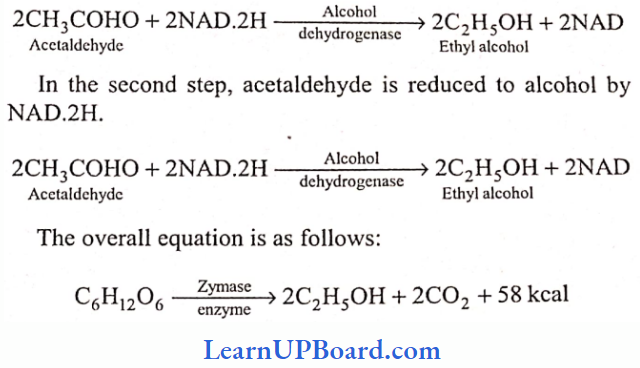
Lactic acid fermentation: Pyruvic acid formed at the end of glycolysis is converted to lactic acid by homofermentative lactic acid bacteria (Lactobacillus lactis).

Lactic acid and ethyl alcohol fermentation

NEET Biology Notes Respiration In Plants Respiratory Inhibitors
Cyanide (CN) and azide (N3–) are effective inhibitors of respiration. However, in plants, this effect is minor. The respiration that continues in this situation is called cyanide-resistant respiration.
The reason that respiration can continue in plants, even when cytochrome oxidase is blocked, is that such mitochondria have an alternative route allowing the transport of electrons to oxygen from ubiquinone to a flavoprotein to oxidase. Phosphorylation is coupled to the pathway. Therefore, it leads mainly to the production of other inhibitors, not ATP. Other inhibitors are rotenone, CO, H2S, barbiturates, malonate, etc.
NEET Biology Notes Respiration In Plants Respiratory Inhibitors Points To Remember
- 264 g of CO2 is liberated during the complete oxidation of 1 80 g of glucose.
- α-ketoglutaric acid is the first dicarboxylic acid formed during the Krebs cycle.
- The number of ATP molecules formed by the complete oxidation of pyruvic acid is 15.
- Mercury is used in anaerobic respiration experiments because it does not react with CO2.
- The rate of respiration is measured by a respirometer.
- Fermentation was discovered by Gay Lussac
- Fruits and seeds are stored at low temperatures to reduce the rate of respiration.
- If a leaf is immersed in a sugar solution, the rate of respiration increases.
- Pasteur effect: A change from anaerobic to aerobic condition decreases the rate of sugar breakdown and CO2 evolution.
- Dinitrophenol inhibits ATP synthesis (uncoupler).
- Oligomycin inhibits oxidative phosphorylation (energy transfer inhibitor).
- Abnormal rise in the respiratory rate of ripening fruits is called climacteric. For example, bananas.
- Higher concentrations of CO2 and the absence of O2 adversely affect the rate of respiration (except in anaerobic respiration).
- One molecule of glucose or fructose produces a total of 38 ATP molecules out of which two are used, and therefore, the net gain of ATP is 36. Out of these 38 ATPs, four are formed by direct (substrate) phosphorylation 32 ATPs by oxidative phosphorylation through ETS, and two by GTP.
- One molecule of NADH2 forms three ATPs, and one FADH2 forms two ATPs through ETS.
- One turn of the Krebs cycle produces 12 ATPs, 11 ATPs through ETS, and one ATP by substrate phosphorylation.
- ATP formation is an endergonic process and occurs in chloroplast and mitochondria.
- Muscles get energy by glycolysis.
- The ratio of CO2 formation in aerobic and anaerobic respiration is 3:1.
- The ratio of ATP in aerobic and anaerobic respiration is 18:1.
- Krebs cycle is basically a catabolic cycle but also functions as an anabolic cycle, hence called an amphibolic cycle. Its starting product is citric acid which is a tricarboxylic acid. It undergoes four oxidations and two decarboxylations to produce CO2 and H2O.
- Cytochromes are Fe+2-rich intrinsic proteins and were discovered by MacMunn. Cyt a3 has both Cu+2 and Fe+2 and acts as cytochrome oxidase.
- Respiration using proteins as substrate is called protoplasmic respiration, while it is called floating respiration when the substrate is carbohydrate or fat.
- Water produced due to the oxidation of reduced coenzymes with the help of O2 is called metabolic water.
- The glyoxylate cycle occurs in seeds that possess tissues rich in fats and enables stored fats to be converted into carbohydrates. Enzymes for the cycle are present in glyoxysomes.
” respiratory balance sheet class 11″
NEET Biology Notes Respiration In Plants Respiration In Plants Assertion-Reasoning Questions
In the following questions, an Assertion (A) is followed by a corresponding Reason (R). Mark the correct answer.
- If both Assertion and Reason are true and the Reason is the correct explanation of the Assertion.
- If both Assertion and Reason are true, but the Reason is not the correct explanation of the Assertion.
- If Assertion is true, but Reason is false.
- If both Assertion and Reason are false.
Question 1.
Assertion: 2,4 DNP is an uncoupling agent in ETS.
Reason: It is soluble in lipids.
Answer: 2. If both Assertion and Reason are true, but the Reason is not the correct explanation of the Assertion.
Question 2.
Assertion: Glucose 6-phosphate dehydrogenase deficiency impairs PPP (HMS).
Reason: It is an X-linked recessive disorder.
Answer: 2. If both Assertion and Reason are true, but the Reason is not the correct explanation of the Assertion.
Question 3.
Assertion: The RQ of maturing fatty seeds is greater than 1.
Reason: Fats are preferred as energy fuel.
Answer: 3. If Assertion is true, but Reason is false.
Question 4.
Assertion: In cellular respiration, ETS electron movement is a downhill journey.
Reason: Electrons move from high redox potential to low redox potential.
Answer: 3. If Assertion is true, but Reason is false.
Question 5.
Assertion: Succinyl CoA is the precursor of pyrrole group-containing compounds.
Reason: Succinyl CoA is an intermediate of the TCA cycle.
Answer: 2. If both Assertion and Reason are true, but the Reason is not the correct explanation of the Assertion.
